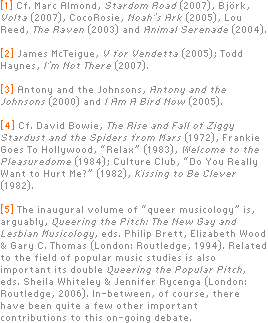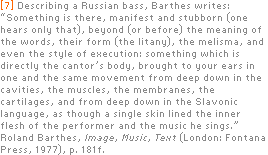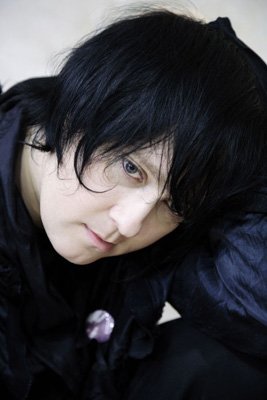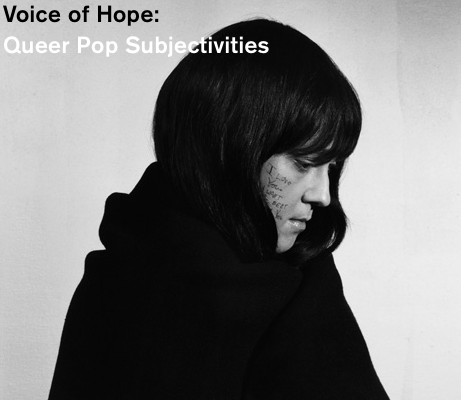| The voice of Antony Hegarty has been close to ubiquitous as of lately. It is part of the sound of artists as diverse as Marc Almond, Björk, CocoRosie, and Lou Reed, to mention only some of those with whom he has collaborated.[1] But it has also been heard in films, such as V for Vendetta, where it is played by the jukebox in an important scene, as well as the recent Bob Dylan film I’m Not There, where Antony is singing “Knocking on Heavens Door”.[2] In addition, of course, there is his own band, Antony and the Johnsons, with their two albums; the self-titled Antony and the Johnsons and I am a Bird Now, with a third album, The Crying Light, due for release in 2008.[3] Born when Ziggy Stardust raided the airwaves, and becoming teenager around the time when Frankie told us to “Relax” and Boy George was asking “do you really want to hurt me?”, Antony might be placed in a long history of popular-music singers.[4] This history questions dimensions of the gendered understanding of popular music, questions having become increasingly persistent in recent years. And co-existing with Antony’s reaching out to a more mainstream audience, the rise of queer studies within musicology might be fruitfully used to discuss Antony’s music.[5] |  | 
| 
|  |  | It is not easy to describe the music on Antony’s albums, but his voice is even more difficult to describe. It is, however, this voice that is the focal point of this article. But the voice never – or hardly ever – exists alone. Even if we often listen to voices as if they were detached from all possible contexts, the voice is still intimately related to other domains, perhaps foremost among them the body. In one sense is it paradoxical to contemplate the voice without a body, but this used to be quite common, and within music scholarship there has been some controversy related to thinking “the body”.[6] But the disembodied voice is at the same time frequently what we hear, for example when listening to a CD. One reason is that the voice is elusive. In “live” situations the voice’s utterance (whether speaking or singing) disappears in the moment it sounds. Listening to a CD, the bodily carrier of the voice might be in another place; we listen to “the voice alone”. And thus, it might seem, it is forgotten that this voice at one time emanated from a body. |  | 
| 
|  |  | Keeping this in mind, the voice still demands attention. There is a power of the voice seemingly drawing us towards it, and this power is part of Antony’s performance too. This does not mean that we should forget the intimate relation between voice and body, but even the “voice alone” as an abstract medium contains traces of the body. What Roland Barthes famously called “the grain of the voice” is, among other dimensions, traces of the body as it is attached to the voice.[7] In this sense we hear the singer’s body, and his – or her – voice is caressing us. There is, then, an erotic relation between singer and listener. The voice, as an abstract entity in the singular, is a construct; there is no singular voice, but rather different vocal expressions. And when we hear a voice, we simultaneously hear a body. The voice emanates from the body, and the body – with all its different characteristics – colors the voice. And this is the case even when thinking of so-called “disembodied voices”. |  | 
| 
|  |  | 
|  | | 
|  |  | 
|  |  | 
|  |  | Remembering the voice’s intimate relation to a body, we immediately also come across issues related to gender and/or sex. Bodies are gendered and sexed, and this has consequences for how we hear – or experience – voices. There is a strong tendency to claim that voices are gendered and/or sexed in a similar manner to bodies, and from this it also follows that as with theories of sexual difference, there are theories of vocal difference. We tend to think we know what a “male” or a “female” voice is. Ascribing gender to a voice seems to be a rather self-explanatory endeavor. And it seems as if sexual difference hardly ever is seen as a problem in this task. There are male voices and female voices, and voices are categorized without much effort into one or the other. Beginning to discuss voices more thoroughly, one finds that there are also other kinds of voices, voices that resist such an easy categorization. Some possible gender-ambivalent voices might be the voice of the castrato, different computer-technologized voices (such as the cyborg-voice), and, to a lesser degree, counter-tenor voices. Here, things become a bit blurrier, given how such voices challenge familiar understandings of the voice. In the case of Antony, as well as the already mentioned David Bowie and Boy George (as well as a host of other singers), these questions are never simple. Different gendered expressions exist also in relation to the voice, as has been discussed, for example, related to androgynous voices. An androgynous voice is per definition neither “male” nor “female”. It might be described as genderless, but also as having “too much” gender to it; thus rather than pointing to a solution to any discussion of the gendered voice, the androgynous voice opens up a totally different field of examination. Yet another dimension might enter the discussion of ambiguities related to voice: the words. Focusing on the lyrics when trying to interpret the voices, we can hear other strategies for negotiating gendered and/or sexed identities. That is to say, it seems somewhat self-evident that the “content” or “message” of a song is communicated by way of the lyrics. Here too we find an abstraction: the singing voice is, so to speak, an entity in-between music (the tones of the song) and word (the lyrics), and these two dimensions together constitute the voice we hear. There is of course the possibility of having a singing voice without words, but when words are included they also contribute to the sound of the voice. Here an example could be listening to songs in languages one doesn’t know or understand. |  | | 
|  |  | 
|  |  |
|

